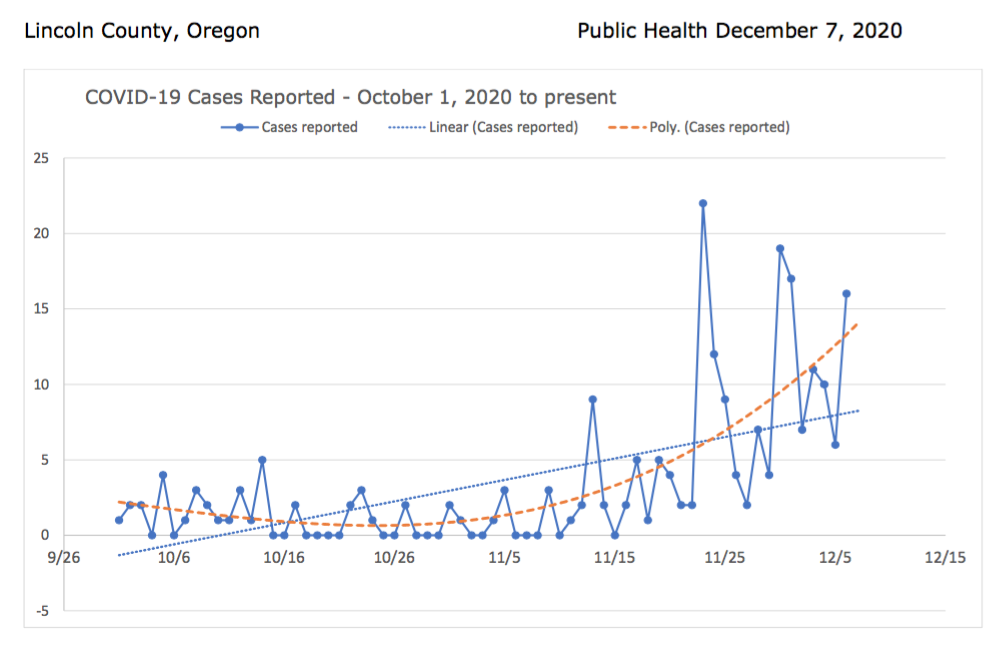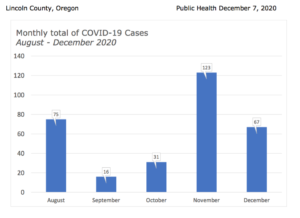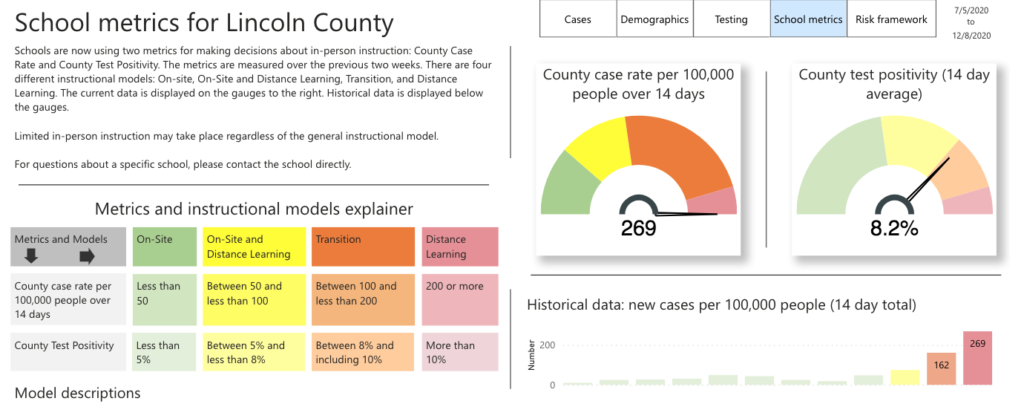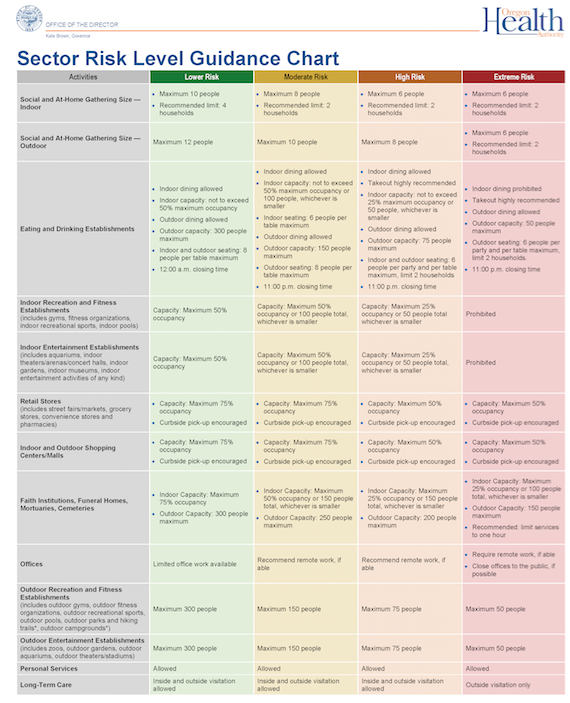
By QUINTON SMITH/YachatsNews.com
Lincoln County residents need to get ready to shut down once again.
The number of COVID-19 cases in the county have grown so numerous – 131 in the last 12 days – that the county will move into the state’s “extreme risk” category Dec. 18, county health officials announced Thursday.
That means indoor dining at restaurants and bars will shut down again, offices workers would be required to work remotely if they can, gyms will close, and indoor entertainment like aquariums and theaters will have to close through New Year’s Eve, Dec. 31.

The surge of cases also led the Lincoln County School District to announce this week it would return all grades to online instruction when school resumes Jan. 4 from its winter break.
The Oregon Health Authority on Tuesday sent a warning letter to the county saying its COVID-19 cases had grown so high that without some sort of drastic drop, the new, tighter restrictions would take effect Dec. 18. Lincoln County is one of five counties in the state’s “high” risk category; 25 counties are “extreme.”
On Thursday, Lincoln County Public Health said the numbers were too high to change course and issued a notice to businesses and residents to prepare for the tighter rules.
“Although there are two days left in the two-week reporting period, our case rate has already surpassed the level to enter ‘extreme risk’ as of Dec. 18,” the county said in its alert.
In addition, there have been six people hospitalized so far this week, a serious trend given the small number of beds in the county’s two hospitals and the fact that just 28 people had been hospitalized for COVID-19 all year.
State and local health officials say the latest surge is the anticipated spike from social gatherings during the Thanksgiving holiday.
How the four categories work
Counties move up or down the state’s four categories – low, moderate, high and extreme – based on the number of COVID-19 cases per 100,000 population.
The first two weeks of November, Lincoln County’s rate was 44 per 100,000 – putting it in the “moderate” category, if the restrictions had been in place then. But by the time they went into effect Dec. 3, the county’s case rate was 161 per 100,000 — putting it in the “high” risk category, which carries tighter restrictions on business and social activities.

Based on the last two weeks, Public Health Director Rebecca Austen said the county’s rate is now 281 per 100,000 people – pushing it above the 200 case per 100,000 threshold for the “extreme” category.
If that’s still the case Monday when the next measurement is taken, that means indoor and outdoor social and at-home gatherings would be limited to six people with a recommended limit of two households, restaurants once again could only offer outdoor dining and takeout food. Retail stores would keep a 50 percent capacity limit, as would outdoor shopping malls. Churches and funeral homes would maintain a 25 percent capacity limit.
Under the state’s new four-stage restrictions, the OHA examines and publishes county data weekly and risk levels are reassigned every two weeks. But the OHA will give counties a “warning week” to prepare for changes – with the first change under the new metric coming Thursday, Dec. 18.
Austen told county commissioners this week that clusters of outbreaks – 28 as of Monday – are “from all over the place.” On Wednesday, the OHA announced a workplace outbreak of eight cases at the Lincoln City Safeway store.
“We can probably get the award for going into 2021 with the worst foot forward,” Austen said.

School district announcement
Because of the surge in cases, the Lincoln County School District said Tuesday it would end “hybrid” instruction for kindergartens through third-graders after the Christmas and New Year’s break and return all students to online classes Jan. 4.
In an email to parents and the community, Superintendent Karen Gray said if cases don’t spike too much the district should be able to continue in-class instruction for the four grades until winter break begins Dec. 19.
Gray said the change is being forced because the spike in cases put the district in a “red” zone, under which state requires it to go to online instruction only.
She said the district still hopes to begin hybrid classes – two days a week in class and two days online – for all grades on Feb. 1.
On Tuesday night, Gray reminded the school board that in early November the district was one of the few in Oregon whose case count was low enough to bring all students back to school two days a week. Instead, administrators chose to try to bring students back in clusters of grades over five weeks — which was foiled when COVID-19 cases began spiking.
That has changed even more with the growing COVID-19 cases from Thanksgiving, Gray said, and will likely get worse after an even bigger surge from the Christmas and New Years holidays.
“It will probably be that way for the entire month of January,” Gray said. “We’ll see another surge mid-January and then I think it will calm down.”
But she termed “heart breaking” the decision to send the district’s youngest students back home for online instruction in January.
“We’ve been successful K-3,” she said. “To turn around now and send those kids home is heartbreaking. But if the numbers don’t go down we can’t go back to school.”
Struggling to keep up

Lincoln County Public Health said its staff is keeping up on case investigations and contact tracing but are now asking the public to help by being proactive in notifications. Sometimes staff are not getting the full picture from the people they speak with because they either forgot a few contacts or they do not want to share who their contacts are, said Florence Pourtal, deputy director of Lincoln County Public Health.
The community can help during the surge by:
- If you know for a fact that you are a close contact of a confirmed COVID-19 case, the county is asking that you start quarantining immediately and not wait for a contact tracer to call;.
- If you learn you had a positive test, make a list of the people you have been around for the 48 hours prior to symptoms or the 48 hours prior to the tests, whichever is earlier. The information contact tracers needs is name, date of birth, and phone number for each contact. This will help speed up the contact tracing process. If comfortable, notify these contacts on your own so they know to quarantine.
“We expected to see an increase in cases this fall and winter, and right now it is increasing at a rate where it is becoming difficult to keep up with all of the contacts,” said Pourtal.
Case investigators have begun prioritizing outbreaks, specifically in high-risk settings such as long-term care facilities and other congregate spaces.
In addition to the positive cases, there are 150 contacts being monitored daily – a substantial increase for Lincoln County. While public health is keeping up, it is having to pull staff in from other programs to keep up with the cases.
Lincoln County has also adapted a COVID-19 outbreak guide from Multnomah County to offer employers at businesses with multiple cases, so they know what information to gather and send to Public Health. The toolkit includes employee sick leave information, protocols on employee testing, and details about when an employee can return to work.
“We have hit our limit,” Pourtal said. “Now we’re asking everyone to be a partner in the work with us.”




